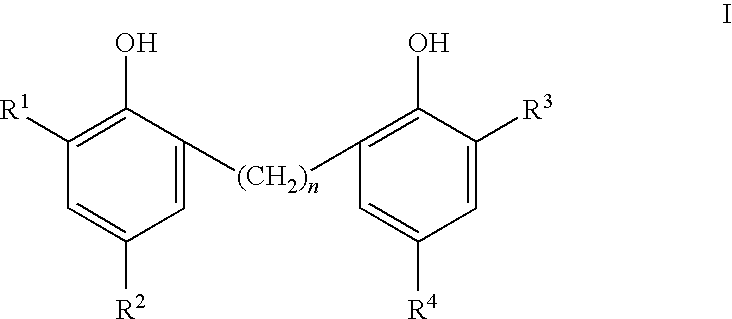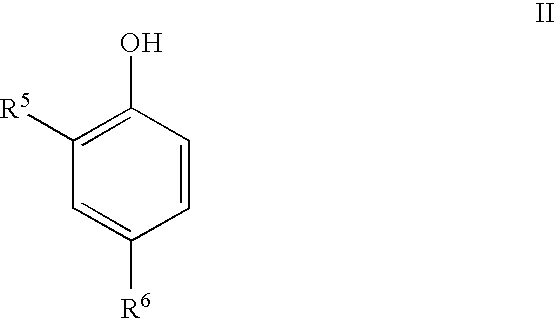Phenolic dimers, the process of preparing same and the use thereof
a technology of phenolic dimers and dimers, which is applied in the field of new phenolic dimers, can solve the problems of oxidation of lubricating oil compositions, and reducing the performance of catalysts
- Summary
- Abstract
- Description
- Claims
- Application Information
AI Technical Summary
Problems solved by technology
Method used
Image
Examples
example 1
Preparation of 4-Polyisobutyl Cresol Dimer
[0111]4-polyisobutyl cresol (1200 g) was placed in a 1 L 3-neck round bottom flask equipped with agitator, temperature controller, Dean-Stark trap and condenser as reactor. Nitrogen blanketing was utilized. The 4-polyisobutyl cresol was heated at 35-40° C. 3-(dimethylamino)propylamine (12 g) was added to the 4-polyisobutyl cresol. A 37% formaldehyde solution (96 g) was added over a 5-10 minute period, via addition funnel subsurface. The temperature of the reaction was maintained at a temperature lower than 60° C. The mixture was agitated for 15 minutes at 60° C. The mixture was then distilled at 150° C., under nitrogen sparging at 1.0 SCFM. The water was collected for 1.0 hour at 150 ° C. The remaining reaction mixture was cooled to about 80° C. Finally, the remaining reaction mixture was filtered through 11 cm filter paper and a pre-coat (15 g). The viscosity of the 4-polyisobutyl cresol dimer solution was 994 cSt. at 100° C.
example 2
Preparation of Overbased 4-Polyisobutyl Cresol Dimer
[0112]4-polyisobutyl cresol dimer (70 g) was placed in a 1 L 3-neck resin flask with bottom outlet equipped with agitator, addition funnel, thermometer, temperature controller, and condenser as reaction. Base oil (200 g) was then added. The mixture was agitated at 500±50 rpm. 2-ethylhexanol (40 g), ethylene glycol (5 g), oleic acid (50 g), and calcium hydroxide (42 g) were added to the mixture. The mixture was then agitated under a vacuum (11″ Hg) and heated to 105° C. The vacuum pressure was then increased to 28.8″ Hg. The mixture was allowed to react for 40 minutes under the vacuum. Then, the vacuum pressure was decreased to 11″ Hg and the temperature was increased to 130° C. The vacuum was then released and more ethylene glycol (18 g) was added, drop by drop, over a 5 minute period, via addition funnel. Carbon dioxide was added as a gas subsurface at 130° C., for 40 minutes, at a rate of 260 cc / min. The temperature was again inc...
example 3
Preparation of Overbased 4-Polyisobutyl Cresol Dimer
[0114]The procedure of Example 2 was followed, except that 100 g calcium hydroxide and 200 g polyisobutyl cresol dimer were used in the reaction.
[0115]The TBN of the resulting lubricating composition was 197. The % calcium, by weight, was 6.13%. The viscosity of the resulting lubricating composition at 100° C. was 118 cSt.
PUM
| Property | Measurement | Unit |
|---|---|---|
| flow rate | aaaaa | aaaaa |
| temperature | aaaaa | aaaaa |
| temperature | aaaaa | aaaaa |
Abstract
Description
Claims
Application Information
 Login to View More
Login to View More - R&D
- Intellectual Property
- Life Sciences
- Materials
- Tech Scout
- Unparalleled Data Quality
- Higher Quality Content
- 60% Fewer Hallucinations
Browse by: Latest US Patents, China's latest patents, Technical Efficacy Thesaurus, Application Domain, Technology Topic, Popular Technical Reports.
© 2025 PatSnap. All rights reserved.Legal|Privacy policy|Modern Slavery Act Transparency Statement|Sitemap|About US| Contact US: help@patsnap.com



